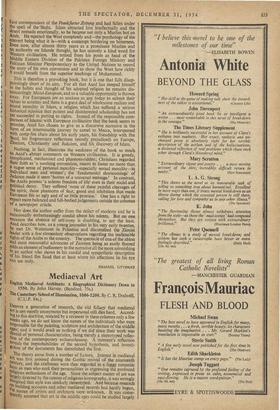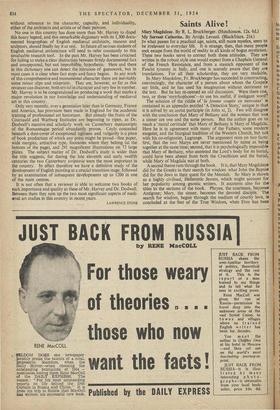Mediaeval Art
The Canterbury School of Illumination, 1066-1200. By C. R. Dodwell. (C.U.P. 84s.)
bESPITE a generation of research, the old fallacy that medieval art is not merely anonymous but impersonal still dies hard. Accord- ing to this doctrine, restated by a reviewer in these columns only a few Weeks ago, we do not know the names of the individuals who were responsible for the painting, sculpture and architecture of the middle ages; and it Would avail us nothing if we did since their work was devoid of personal characteristics, being merely a stereotyped reflec- tion of the contemporary weltanschauung. A moment's reflection reveals the improbabilities of the second hypothesis, and investi- gation of the documents has demolished the first. without reference to tne character, capacity, and individuality, either of the architects and artists or of their patrons.
No one in this country has done more than Mr. Harvey to dispel this hoary legend, and this remarkable dictionary with its 1,300 docu- mented biographies of English medieval architects, masons and sculptors, should finally lay it at rest. In future all serious students of English medieval architecture will need to refer constantly to this invaluable research tool. In the past Mr. Harvey has been criticised for failing to make a clear distinction between firmly documented fact and unsupported, but not improbable, hypothesis, Here and there in this dictionary one can detect the intrusion of guesswork, but in most cases it is clear when fact stops and fancy begins. In any work of this comprehensive and monumental character there are inevitably some minor slips and misprints. They are, however, so far as this reviewer can discover, both trivial in character and very few in number. Mr. Harvey is to be congratulated on producing a work that marks a major revolution in our knowledge and understanding of medieval art in this country.
Only very recently, over a generation later than in Germany, France and America, has provision been made in England for the academic training of professional art historians. But already the fruits of the Courtauld and Warburg Institutes are beginning to ripen, as Dr. Dodwell's massive and scholarly work on Canterbury manuscripts of the Romanesque period abundantly proves. Coyly concealed beneath a dust-cover of exceptional ugliness and vulgarity is a piece of book production of which any press might be proud—fine paper, wide margins, attractive type, footnotes where they belong (at the bottom of the page), and 291 magnificent illustrations on 72 large plates. The subject matter of Dr. Dodwell's study is wider than the title suggests, for during the late eleventh and early twelfth centuries the two Canterbury scriptoria were the most important in the country. In effect therefore we have a definitive study of the development of English painting at a crucial transition stage, followed by an examination of subsequent developments up to 1200 in one of the main centres.
It is not often that a reviewer is able to welcome two books of such importance and quality as these of Mr. Harvey and Dr. Dodwell. Between them they sum up the two most significant aspects of medi- eval art studies in this country in recent years.
LAWRENCE STONE



























 Previous page
Previous page